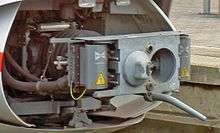Scharfenberg coupler
The Scharfenberg coupler[1] (German: Scharfenbergkupplung, abbreviated Schaku) is a commonly used type of fully automatic railway coupling.


Designed in 1903 by Karl Scharfenberg in Königsberg, Germany (today Kaliningrad, Russia), the coupler has gradually spread from transit trains to regular passenger service trains, although outside Europe its use is generally restricted to mass transit systems. The Schaku is superior in many ways to the AAR (Janney/knuckle) coupler because it also automates electrical and pneumatic connections and disconnections. However, there is no standard for the placement of these electro-pneumatic connections. Some rail operators have placed them on the sides while others have placed them above the mechanical portion of the coupler. The main disadvantage of the Scharfenberg coupler is the relatively low maximum tonnage it can support, which makes it unsuitable for freight operations.
The face of the Scharfenberg coupler has a protruding cone and a matching cup. Inside the cone there is a rigid metal hoop connected to a revolving, spring-loaded metal disk with a notch on the opposite side. When ready to couple, the spring turns the disk so the hoop is extended from the cone. As the cars meet, the hoop enters the cup on the other coupler, stopping against the disk. The hoops are then pressed back into their own coupler, causing the disks to rotate until the notches align with the hoops. After the hoops have entered, the notches on the disks spring back into the hoop extended position, locking the coupling. In the coupled position, forces on the hoops and disk will balance out, which means that the Scharfenberg, unlike many other couplers, is not dependent on heavy latches to stay locked.
Small air cylinders, acting on the rotating heads of the coupler, ensure the engagement of the components, making it unnecessary to use force to get a good coupling. Joining portions of a passenger train can be done at very low speed (less than 3 km/h or 2 mph in the final approach), so that the passengers are not jolted. One problem with the coupler is that it is often hard to connect it in a curve. Planned coupling is normally done on a straight flat track, while there has been trouble coupling a broken down train at an unplanned place.
Uses
Rail equipment manufacturers such as Bombardier offer the Schaku as an option on their mass transit passenger cars and locomotives. Presently, Scharfenberg couplers are in use on the following passenger transit systems:
United States
- San Francisco Bay Area - BART (New Type D and E vehicles)
- Denver - RTD Bus & Rail (New light rail vehicles)
- Baltimore - Baltimore Light Rail (New light rail vehicles)
- New Jersey - New Jersey Transit (New light rail vehicles)
- Portland, Oregon - TMTC (Light rail vehicles)
- Minneapolis - METRO (Light rail vehicles)
Europe
- Thalys
- TGV – All French high-speed trains are equipped with Scharfenberg type 10 couplers.
- ICE – All German high-speed trains are equipped with Scharfenberg type 10 couplers.
- Rhine-Ruhr Stadtbahn - Almost all German light-rail and streetcar systems use Scharfenberg couplers.
- SBB Cargo – In 2019, the swiss freight operator introducing cargo wagons with Voith CargoFlex, an extension of Scharfenberg type 10 couplers.
- Channel Tunnel - Eurotunnel Le Shuttle
Brazil
Singapore
Additionally, the coupler is in use on some multiple unit trains in Australia.
Types

- Type 10
- 2008/232/EC "a technical specification for interoperability relating to the ‘rolling stock’ sub-system of the trans-European high-speed rail system" 4.2.2.2.2.1.: "Automatic centre buffer couplers shall be geometrically and functionally compatible with a 'Type 10 latch system automatic centre buffer coupler' (also known as the 'Scharfenberg' system)"[2]
- used for high-speed rail ICE, TGV, AVE S-102, Frecciarossa
- Type 35
- Type 330
- Type 430
- Unknown designation: The variant used for the Eurotunnel shuttles had to be particular strong: As one engine had to be capable of starting a shuttles in an emergency, the required maximum starting force to be handled is 400 kN.
See also
- Janney coupler
- Draft gear
- Railway coupling by country
References
- us.voithturbo.com: Scharfenberg coupler
- eur-lex.europa.eu: Commission decision of 21 February 2008
External links

- Scharfenberg coupler animation